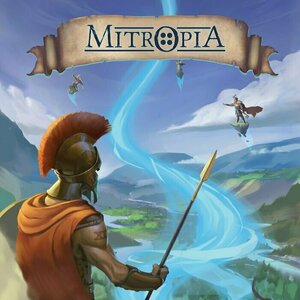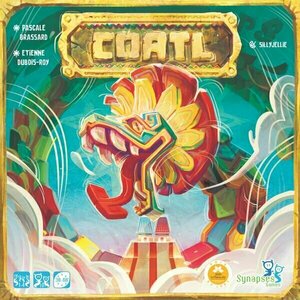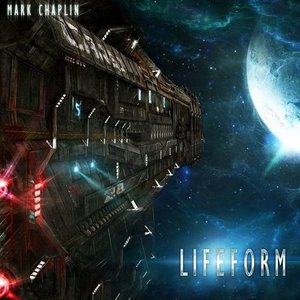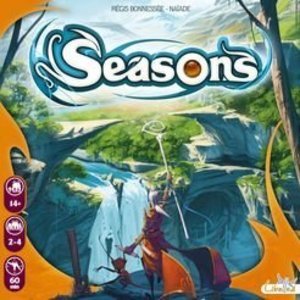
Hanamikoji
Tabletop Game
Welcome to the most famed Geisha street in the old capital, Hanamikoji. Geishas are elegant and...
Purple Phoenix Games (2266 KP) rated Mitropia in Tabletop Games
Apr 21, 2020
Mitropia is an area majority game that can end in several fashions. To setup your first game, please use the setup instructions in the rule book to form the playing area. However, the more you play, the more you might like to change it up and try out some wacky board formations. Every player receives a player mat featuring a tribe with different special abilities. They will each also receive the matching colored warrior tokens (and bag if present), cards from the two decks according to the setup in the rules. Each player will place their chieftan (two stacked warrior tokens) on the board. The game is ready to be played!
DISCLAIMER: We were provided a near-retail prototype copy of this game for the purposes of this review. These are preview copy components, and I know the final components will be a little different from these shown (upgrades!). Also, it is not my intention to detail every rule in the game – and the rules will certainly be tweaked from this version and the rules we used to play it. You are invited to download the rulebook from the publisher’s website, back the game through the Kickstarter campaign running April 16 – May 17, 2020, purchase it from your FLGS, or through any retailers stocking it after fulfillment. -T
Game play is relatively simple. Players are attempting to score points by occupying and/or surrounding terrain tiles. Some tiles are worth more points than others depending on tribe abilities and other factors. The game ends once there are no more legal plays, all players have passed, or a chieftan has been captured by an opponent. Points are then tallied and a victor is determined.
On a turn, a player will make a “move,” which is a strange term as the player is actually placing out a warrior token. The placement of the warrior is dependent upon a move pattern card that is showing on the player mat, or one from the player’s hand to be discarded. These move cards show where the warrior can be placed (like Onitama‘s movement cards). Move cards can be combined with special action cards to make interesting warrior placement upon the board. Again, the goal of the game is to encompass as much terrain as possible, and surround your opponents to capture their warrior tokens.
In addition to simply placing out new warriors to claim lands and surround opponents, using terrain types to their fullest is a strategy not to be ignored. Wormholes are teleport locations, and mountains are impassable. Using just these features can wreak havoc on unsuspecting opponents. Mountains can especially be brutal when being used as an obstacle to facilitate surrounding enemies. When you play Mitropia be warned: mind the mountains.
Play continues in turns until a win condition or game end condition has been met. The players tally points to declare a victor, and then setup to play again for the player will definitely want to play another.
Components. Again, this is a near-retail prototype copy, so the components are very close to what will be available and in each box upon a successful Kickstarter campaign. That said, these components are amazing! I told the publisher the day after receiving the game that I was very impressed with what was packed in the box. Now, I haven’t been able to Tetris the components back in the box and have the cover fit flush since I opened it, but what is inside the box truly is wonderful. The player discs are all nicely-painted wood bits. The player mats, cards, and terrain tiles are all great quality. The art on everything is super stellar, and I just love playing with everything! You know the feeling when you’re playing a game that just has that perfect tactile quality? That’s Mitropia. And this copy isn’t even upgraded!
So here are my thoughts on this beast. I have never played Go, and I’m not really sure I want to after having Mitropia in my hands. I probably will play Go sometime, but I can only picture myself wishing I had been playing Mitropia. There is just something about having special abilities and slight differences that really improves my enjoyment. I love being able to see my turns several rounds in advance, but then having to switch tactics because an opponent has thwarted my evil plan at the last moment. I love being able to sit and think about my plays. I do not suffer from analysis paralysis, and this is a caveat I have for the game – do NOT play with AP-prone opponents. There is a lot going on here and so many options on a turn. AP sufferers can just stare at the board frightened of playing the wrong move or deciding whether or not to play a special ability card. However, I think this is a fantastic game with an excellent theme overlaid. If you are looking for a thematic game of Go that looks beautiful, is colorful instead of boring, allows players to have special powers and abilities, card play similar to the award-winning Onitama, then you certainly owe it to yourself to give a look at Mitropia. Please head over to the Kickstarter campaign that ends May 17, 2020 and check it out to learn even more and see what others are saying about it. I will be guarding my copy like you wouldn’t believe.
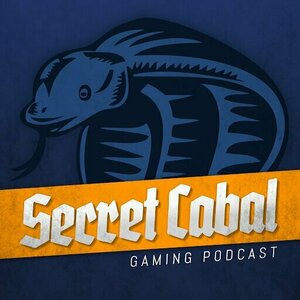
The Secret Cabal Gaming Podcast
Podcast
Five old friends of more than 20 years come together to produce a high quality, bi-weekly podcast...
Boardgames Games Tabletop
Paul Kellett (118 KP) rated Lifeform in Tabletop Games
May 1, 2019
So, what is the game?
Basically, it is Alien: The Board Game. A highly thematic one against many survival game where some of you play the crew of the mining ship Valley Forge trying to escape the clutches of an unknown alien killer before the ship self-destructs. Sound familiar? You bet, and it captures the tension of that well-known film perfectly.
I arrived part way through a game and Tristan kindly gave up his seat to let Me jump in. I basically new nothing about how to play, having only watched a couple of demo videos earlier in the week but with a crib sheet in front of Me explaining the card icons and a quick run down of what you can do in a turn, it didn't feel overwhelming and I was able to take over quite seamlessly. The game was close to the end and the alien player had already taken out most of the crew and was set up very nicely to ambush the rest of us. It wasn't long before the ship was adrift with just one deadly occupant...
How does it work?
We played a basic game, so some of the more meatier options were not included and we just had the simple task of gathering enough equipment and escaping in the shuttlecraft.
In the full game, players will be assigned personal objectives like downloading the ship's log from the data core or gathering specific equipment. This will add much more depth to the game as each player will be striving to achieve these goals as well as trying to avoid the alien and reaching the escape shuttle.
In the simple game however, we just had to focus on escaping. To do this, you need to collect the equipment tokens that are arranged in various rooms on the board. These are then placed on a track at the side of the board in various slots for coolant, energy cells, weapons, space suits and halon canisters. Most of these tracks have a minimum number of tokens needed before you can attempt to escape and any extra will grant bonuses like drawing extra cards or gaining a flame thrower.
In your turn, you get to perform one action so the downtime is minimal and the turns fair zip around the table, often before you've had a chance to take a breath and plan your next move.
All the actions are played from the cards you have in your hand, so you feel the tension of needing to get somewhere but having to wait until you draw a card that lets you run through multiple rooms.
Drawing cards. Now there's a thing. The ship's self destruct has been activated (naturally) and you only have 30 minutes until the ship blows up. Each time you choose to draw more cards into your hand, you slide the marker up the track, closer to the big bang.
I can't say too much about what the alien player can do as I didn't get to study that side of things too much but it certainly has some devious tricks up it's sleeve.
The alien player starts with two standees on the board. They look identical besides a little coloured sticker (this will be a set of symbols in the final game). He also has a corresponding set of tokens next to his player board and he will choose one of these to be the alien. The other standee (or standees, as later in the game there is the chance to get a third standee out) is a decoy so the crew, essentially seeing these as blips on their trackers, never know which is the real threat until it's too late.
There is a nice twist here, as, after making a kill, the alien player get's to reset his tokens and choose again which one will be the decoy and which will be the real killer. The alien player can also choose whether the kill was silent, offing the victim quickly and cleanly, or whether it is a nasty, brutal affair with lots of screaming. If the latter, then the other crew members hear this and all have to make a panic move into an adjacent room. This can be really useful if the crew are about to pick up equipment or possibly achieve an objective (I'm not sure if the personal objectives will be common knowledge or not sat this point).
The alien has various little trackers it can use from hatching more eggs letting it increase the amount of cards it holds, to taking control of the android on the crew which will then get placed on the board and follow a programmed track, killing any crew in it's way until it gets to the escape shuttle where it will start sabotaging various systems.
The alien also gets to place terror tokens and power out tokens on the board. If you enter a space with a terror token, you have to draw a card from the terror deck and these are always bad. A room with a power outage is dark and you can't run through it, you must stop your movement there. Other bad things can happen in the dark too.
What if I die?
Another neat thing this game does is avoid player elimination by cycling the crew. In our game, there were two of us controlling two characters each and when both of My characters died, I took one from the other player so we had one each. When that character was also killed (yes, I was not doing well...), rather than being forced to sit out the rest of the game, I could choose one of two secondary roles to play.
I could take control of the ship's mainframe computer which would allow me to do things like open and close bulkhead doors, slowing the alien down, allow the other players to draw more cards and various other useful things.
Or I could play the ship's cat. This was the option I went for and it was great. I could distract the alien, destroy some of it's eggs (so reducing it's hand size), place additional equipment tokens on the board or assist the other crew by letting them draw more cards.
It was this that that actually gave us the win as it was looking pretty bleak towards the end, but the cat actually managed to guide the last remaining crew member to a flamethrower and distract the alien long enough to make our escape.
What do I think?
This game is superb. Easy to pick up, but very thematic and definitely very tense. The decisions can be easy at times, but then you will hit a situation where the alien has you cornered and you must make some hard choices.
As I said, the theme just drips off every part of this game like a slightly corrosive drool. Our game started off really well - we managed to quickly gather a massive chunk of the equipment we needed to escape but the alien had been cutting the power and placing terror tokens closer to the escape shuttle ready for our eventual arrival and by the mid-game, we were feeling trapped and the alien was using the ventilation ducts to spring out and take us down one by one.
We were down to one surviving crew member and the ship's cat who, as I already mentioned managed to lead the human to the safety of the shuttle and espace.
Just getting to the shuttle isn't the end, however, there is one last twist (as in all good stories). At around the mid-point of the self destruct track, the alien get's to pick a card which is his estimate on what point prior to the ship blowing up we will reach the shuttle. If he has guessed correctly, then as we leave the stricken mining vessel, we find out that the shuttle has one extra occupant...
We were lucky and the alien player had guessed incorrectly, but had he been right, then there would have been a final battle aboard the escape shuttle and we may have been sending some deadly cargo back to Earth...
I can highly recommend this game and best of all, there is an expansion that adds an AI deck and a whole other set of objectives for solo play. I had a quick look at this and it looks like it will make for a very tense and really exciting solo game as well as a cool multiplayer experience.
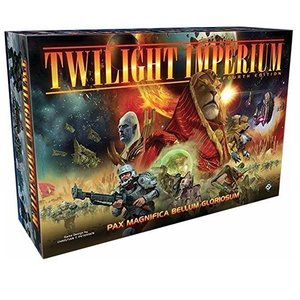
Twilight Imperium Fourth Edition
Tabletop Game Watch
Twilight Imperium (Fourth Edition) is a game of galactic conquest in which three to six players take...
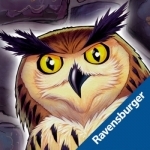
Whoowasit? - Children's game of the year 2008
Games and Entertainment
App
Whoowasit? has been nominated in the categories „Bestes Kinderspiel“ (best game for kids) and...
Purple Phoenix Games (2266 KP) rated Seasons in Tabletop Games
Jul 6, 2019 (Updated Nov 4, 2021)
Seasons is a fantastical dice rolling, card drafting, hand management game for two to four players. In it, players are sorcerers competing in a legendary magical tournament that spans three years in an attempt to be crowned the next Archmage of the kingdom. As the seasons change, sorcerers may draw power from changing mana sources, and utilizing these sources most efficiently and effectively will earn victory over all. So tighten up your belt and get to casting, young mage!
To setup, follow the rules in the rulebook (there are many steps, and I have feeble and weak fingers) until the table looks somewhat similar to the photo below – except for the obvious oversight in placing the orange cube on the zero space of bonus actions. The main areas of interest are the main game board where the years and seasons are tracked, the Crystal score track, and player board/tableau area. Players will be dealt a hand of nine cards to start, and then draft one card at a time, passing to their neighbor each time, and deciding which three cards they would like to start the game with, and assigning three more cards each into the Library for rounds two and three. The game begins in Winter, and the black cube is placed on the number 1 of the seasons board. The game is now setup and ready to begin with the first player!
Each turn the active player will roll all dice in the current season (this game is setup for two players, so three total dice are used each turn). They will choose one die to use for the turn, and other players will choose theirs. The players then gather the resources present on the die face. These could be element tokens, crystals (VP), summon gauge stars, cards drawn from the deck, or even transmutation powers. Once resources are gained, the active player may then choose to play a card from their hand to their personal tableau, given they have adequate summoning power (the number of cards that can be played) available on their board. The cost to play the card is found under the illustration, and is usually paid in crystals, element tokens, or a combination of both. These Power Cards may allow the player immediate benefits, ongoing benefits, or benefits that may be activated at certain times during the game.
Another option players have from their chosen die is the ability to transmutate. When a player chooses a die with this option, they are able to consult the current season on the main board and exchange element tokens for crystals, depending on the provided exchange system. For example, a player wishing to exchange earth tokens (the green plant) during Winter will be provided with three crystals each, while attempting the same transmutation during Spring will only provide one crystal each.
Once each player has taken their turn to collect their resources, complete their turn actions, and pass onto the next player, the unchosen die is resolved. Each die face also shows a number of dotted pips at the bottom. The number of pips shown on the unchosen die refers to the number of spaces the cube on the main board season tracker is to be moved forward around the board. One pip, one space forward. This could result in the current season continuing or progressing into the next season. When the cube progresses from Fall to Winter, players will collect their cards set aside for year two or three, respectively. These cards are added to their hand and available to be used immediately on their turn. If, however, on their turn a player has little they can do, or simply wish to boost their turn, they may use one of four bonus actions, as printed on their player board. These actions allow the player to trade two element tokens from their reserves for any other two element tokens from the main supply, allow transmutation if the symbol is not present on their chosen die face, increase their summoning gauge by one, or draw two power cards from the deck and choose one to add to their hand instead of drawing one, per their die face. Each player can use three total bonus actions for each game at a cost of crystals for each usage. Certainly a trade-off.
Play continues in this fashion of choosing and resolving dice, playing cards, and transmuting tokens for crystals until the cube has completed its three year journey around the main board. At that time crystals are scored from cards and added to the tracker, with five points deducted for each card remaining in hand and points deducted for the usage of bonus actions. The player with the most crystals at the end of the game is the winner!
Components. I have a lot to say here, but will attempt to be as succinct as I can. The components in Seasons are simply phenomenal. Yes, the boards, cards, and cubes are all fine quality and unimpressive. However, the art style throughout the game and those big chunky dice are the real standouts to me. I mean, who DOESN’T like to roll big, chunky dice? And the player colors? Oh man, I love them! Players can choose orange, purple, gray, or lime green. Those are some great color options, and such a simple upgrade from primary colors used on many other games. The dice are primary colors, but I still enjoy them and I will let it slide. No real complaints on components from me. I have heard complaints about people not vibing on the color choices associate with the elements/energy, but I applaud the mold-breaking here. Why can’t Fall be red and associated with a feather? Why can’t Summer be yellow and associated with a flame? Fire doesn’t always have to be red. Go on, Seasons! Be you!
Our thoughts on each game should never be a surprise. I will say this for Seasons – I believe that when I auctioned it off the first time, part of the reasoning was because I did not fully understand the rules. I was a newer gamer at the time and was lured in by colors and art style (which are still stunning). More than likely I thought I was smarter than I truly am and included all the cards in my first plays instead of heeding the suggestions given by the rulebook for easier first games. Now, being a more seasoned (I couldn’t resist) gamer, I can better appreciate what is in this box. The unique card play, the dice drafting for resources and actions, the progression of time as a result of the rejected die, all come together to make a very solid and different game. I am trying to think my way through my collection to find a parallel that uses all these mechanics together as well as Seasons does and I am finding it difficult. It is so easy to just throw mechanics into a blender and see the goo that results, but everything with Seasons feels right and I am just in love.
Why did I ever get rid of Seasons? I will claim young and dumb, though I wasn’t very young. Do not emulate my decision to shed this one out of your collection. You don’t have a copy? I would recommend visiting your FLGS to see if they might have a copy in stock. It’s a great one, and one that I will treasure from here on out. Purple Phoenix Games officially gives this one an amazingly colorful 5 / 6. I know the others will enjoy it too, but until they play it, I will be giddy with excitement each time I am able to play my copy. Why are you still here? Go get Seasons!
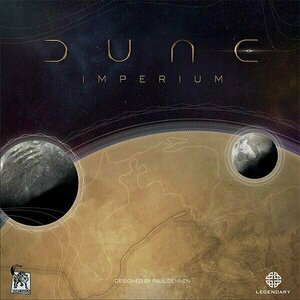
Dune: Imperium
Tabletop Game
Dune: Imperium is a game that finds inspiration in elements and characters from the Dune legacy,...
